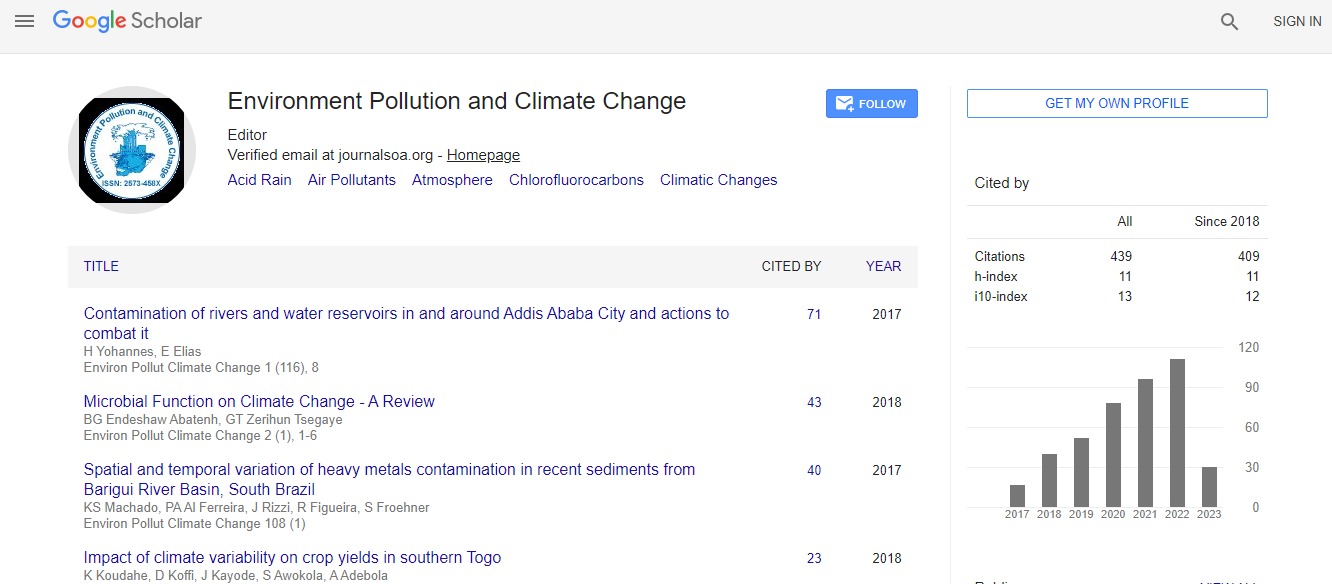Our Group organises 3000+ Global Conferenceseries Events every year across USA, Europe & Asia with support from 1000 more scientific Societies and Publishes 700+ Open Access Journals which contains over 50000 eminent personalities, reputed scientists as editorial board members.
Open Access Journals gaining more Readers and Citations
700 Journals and 15,000,000 Readers Each Journal is getting 25,000+ Readers
Google Scholar citation report
Citations : 672
Environment Pollution and Climate Change received 672 citations as per Google Scholar report
Environment Pollution and Climate Change peer review process verified at publons
Indexed In
- Google Scholar
- Publons
- Euro Pub
- ICMJE
Useful Links
Recommended Journals
Share This Page
Identification and characterization of Peruvian native bacterial strains as bioremediation of Hgpolluted water and soils due to Artisanal and Small-Scale Gold Mining in the Secocha Annex, Arequipa
Global Summit on Environmental Health
Patricia Lopez Casaperalta
Universidad Cat√?¬≥lica de Santa Mar√?¬≠a, Peru
ScientificTracks Abstracts: Environ Pollut Climate Change
Abstract
Statement of the Problem: The water and soils pollution due to mercury emissions from mining industries represents a serious environmental problem and continuous risk to human health. Among the 25 regions of Peru, three are responsible for more than 70 percent of the official gold production, La Libertad (29.6%), Cajamarca (25.9%) and Arequipa (15%). However, illegal mining in some Peruvian regions has been increasing. Secocha annex located in the Mariano Nicol√?¬°s Valc√?¬°rcel district in the Caman√?¬° province, Arequipa, has seen a tremendous boost activity due to the poor legislation on the use and type of land, which has caused informal settlements dedicated to mining. With gold reserves of narrow high-grade veins, where the width range of the vein is from 1 and 10 cm and its grades vary between 10 and 30 g/ton, this zone suffers the consequences of gold overexploitation and environmental mercury pollution. In 2018, the residents asked the Ministry of the Environment to declare Secocha in a state of sanitary emergency due to the high contamination by mercury of the soils and aquifers. Likewise, they also requested to identify the effect on the health of the inhabitants, especially in children, pregnant women, and the elderly. The main objective of this work was to identify bacterial strains obtained from contaminated soils of the Peruvian region of Secocha, which have growth capacity on mercury substrates to evaluate their adsorption behavior and mercury removal capacity. Through DNA analysis (99.78% similarity), and atomic absorption spectrometry, the gram-positive bacterium Zhinhengliuella alba sp. T2.2 was identified as the strain with the highest mercury removal capacity from culture solutions with an initial Hg mercury concentration of 162 mg√?¬∑L-1. The removal capacity reached values close to 39.5% in a period of incubation time of 45 days, with maximum elimination efficiency in the first 48 hours. These results are encouraging and show that this native strain may be the key to the bioremediation of water and soils contaminated with mercury. The importance of reducing the use and emission of mercury in mining activities is obvious, and the Peruvian government has implemented several strategies to do so, as besides being one of the countries that signed and ratified the Minamata Convention. In addition to that, the remediation and sanitation of the different environmental sources are required for the protection of human health. In this context, different techniques are used for this purpose. However, remediation by microorganisms has proven to be an economical technique, being the most environmentally friendly and a great option for the sustainability of contaminated systems using endogenous bacteria.Biography
Dra. Ing. Patricia López Casaperalta specialist in environmental sciences and technologies with experience in environmental assessment and impact in mining and industrial processes. With determination and passion to improve safety, health and care for the environment. She is director of the Mining Engineering program of catholic university of Santa Maria, where she develops research, management and university teaching tasks. Her article entitled Identification and characterization of native Peruvian bacterial strains as bioremediation of water and soil contaminated with Hg due to Artisanal and Small-Scale Gold Mining in the Secocha Annex, Arequipa. Has allowed identify and to register bacteria with the capacity for bioremediate soils contaminated with mercury as a result of mineral extraction. demonstrating that bioremediation is a promising, economical and viable alternative

 Spanish
Spanish  Chinese
Chinese  Russian
Russian  German
German  French
French  Japanese
Japanese  Portuguese
Portuguese  Hindi
Hindi 
